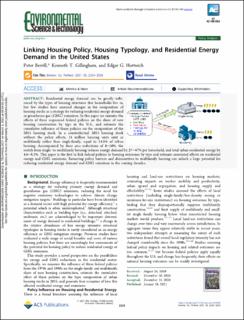| dc.contributor.author | Berrill, Peter | |
| dc.contributor.author | Gillingham, Kenneth T. | |
| dc.contributor.author | Hertwich, Edgar G. | |
| dc.date.accessioned | 2021-11-04T11:35:20Z | |
| dc.date.available | 2021-11-04T11:35:20Z | |
| dc.date.created | 2021-06-09T17:39:14Z | |
| dc.date.issued | 2021 | |
| dc.identifier.citation | Environmental Science and Technology. 2021, 55 (4), 2224-2233. | en_US |
| dc.identifier.issn | 0013-936X | |
| dc.identifier.uri | https://hdl.handle.net/11250/2827848 | |
| dc.description.abstract | Residential energy demand can be greatly influenced by the types of housing structures that households live in, but few studies have assessed changes in the composition of housing stocks as a strategy for reducing residential energy demand or greenhouse gas (GHG) emissions. In this paper we examine the effects of three sequenced federal policies on the share of new housing construction by type in the U.S., and estimate the cumulative influence of those policies on the composition of the 2015 housing stock. In a counterfactual 2015 housing stock without the policy effects, 14 million housing units exist as multifamily rather than single-family, equal to 14.1% of urban housing. Accompanied by floor area reductions of 0–50%, the switch from single- to multifamily housing reduces energy demand by 27–47% per household, and total urban residential energy by 4.6–8.3%. This paper is the first to link federal policies to housing outcomes by type and estimate associated effects on residential energy and GHG emissions. Removing policy barriers and disincentives to multifamily housing can unlock a large potential for reducing residential energy demand and GHG emissions in the coming decades. | en_US |
| dc.language.iso | eng | en_US |
| dc.publisher | American Chemical Society | en_US |
| dc.relation.uri | http://dx.doi.org/10.1021/acs.est.0c05696 | |
| dc.rights | Attribution-NonCommercial-NoDerivatives 4.0 Internasjonal | * |
| dc.rights.uri | http://creativecommons.org/licenses/by-nc-nd/4.0/deed.no | * |
| dc.title | Linking Housing Policy, Housing Typology, and Residential Energy Demand in the United States | en_US |
| dc.type | Peer reviewed | en_US |
| dc.type | Journal article | en_US |
| dc.description.version | publishedVersion | en_US |
| dc.source.pagenumber | 2224-2233 | en_US |
| dc.source.volume | 55 | en_US |
| dc.source.journal | Environmental Science and Technology | en_US |
| dc.source.issue | 4 | en_US |
| dc.identifier.doi | 10.1021/acs.est.0c05696 | |
| dc.identifier.cristin | 1914907 | |
| cristin.ispublished | true | |
| cristin.fulltext | original | |
| cristin.qualitycode | 2 | |

